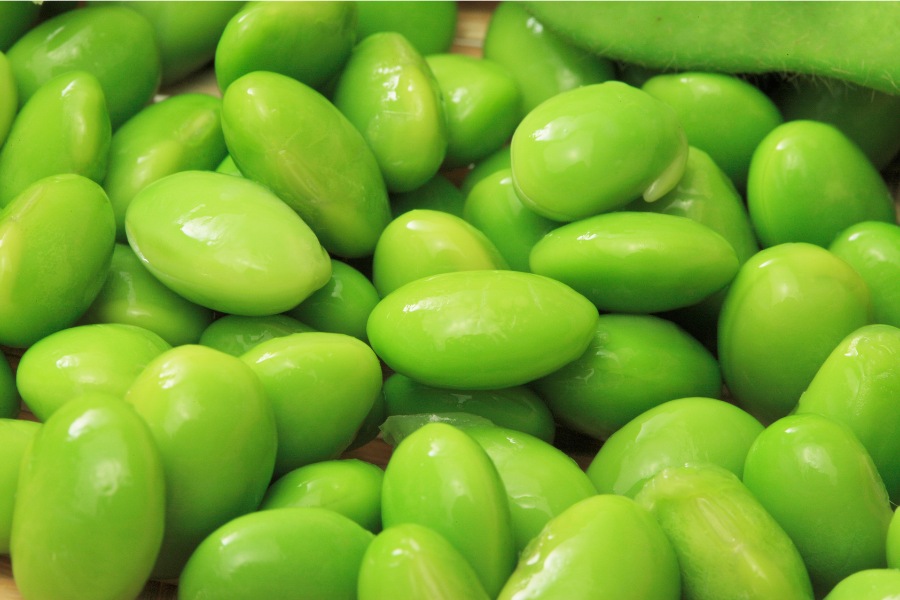
Healthy Snacks for People with Diabetes
Table of Contents
ToggleIntroduction to Healthy Snacking for People with Diabetes
As someone who has been living with diabetes for several years now, I understand the importance of making smart and nutritious choices when it comes to snacking. Snacks can be a tricky part of managing diabetes, as it is crucial to choose options that won’t cause blood sugar spikes. The good news is that there are plenty of healthy and delicious snacks that are perfect for people with diabetes. In this article, I will share 15 of my favorite snacks that are not only diabetes-friendly but also packed with nutrients to support overall health.
The Importance of Choosing Healthy Snacks for Diabetes Management
Snacking plays a significant role in diabetes management. When you have diabetes, it is essential to choose snacks that won’t cause your blood sugar levels to skyrocket. Opting for snacks that are low in carbohydrates and sugar can help maintain stable blood sugar levels throughout the day. Additionally, incorporating snacks that are high in fiber, protein, and healthy fats can provide sustained energy and help you feel satisfied between meals. By making mindful snack choices, you can better control your blood sugar levels and support your overall well-being.
Almonds – A Nutritious and Satisfying Snack for Diabetes
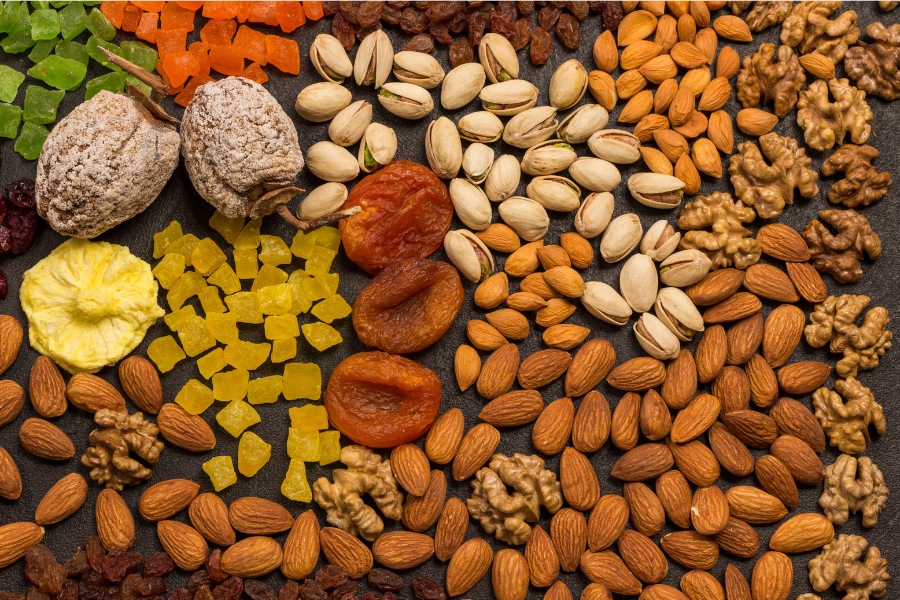
Almonds – A Nutritious and Satisfying Snack for Diabetes
Almonds stand out as an exceptional choice for those managing diabetes, offering a blend of essential nutrients that promote health and well-being. These nuts are rich in healthy fats, protein, and fiber, contributing to blood sugar stabilization and prolonged satiety. Moreover, almonds are a source of vitamin E, magnesium, and antioxidants, all of which have been linked to various health advantages. Research indicates that consistent consumption of almonds may enhance insulin sensitivity and lower heart disease risk. For a nutritious snack, a modest handful of almonds provides both crunch and natural sweetness.
Here’s why almonds are beneficial for individuals with diabetes:
- Fiber Content: Almonds are high in fiber, which moderates blood sugar absorption, aiding in the avoidance of spikes. Each ounce of almonds offers around 4 grams of fiber.
- Healthy Fats: These nuts are laden with beneficial fats that not only help satiate hunger but also contribute to heart health through their monounsaturated fat content.
- Carbohydrate Count: With just 6 grams of carbohydrates per ounce, almonds are a smart, low-carb snacking option, supporting stable blood sugar levels.
- Magnesium Rich: Essential for regulating blood sugar, magnesium is abundant in almonds, with an ounce providing roughly 80 mg.
Beyond these qualities, almonds also supply protein, vitamin E, and manganese, vital nutrients for maintaining health.
While almonds are nutrient-dense, they are also high in calories, necessitating mindful consumption. An ounce, or roughly a small handful, is an ideal serving size. Almonds can be savored alone or added to dishes like yogurt, oatmeal, or salads for enhanced flavor and nutrition.
Apple slices with peanut butter – A delicious and well-balanced snack option for diabetics
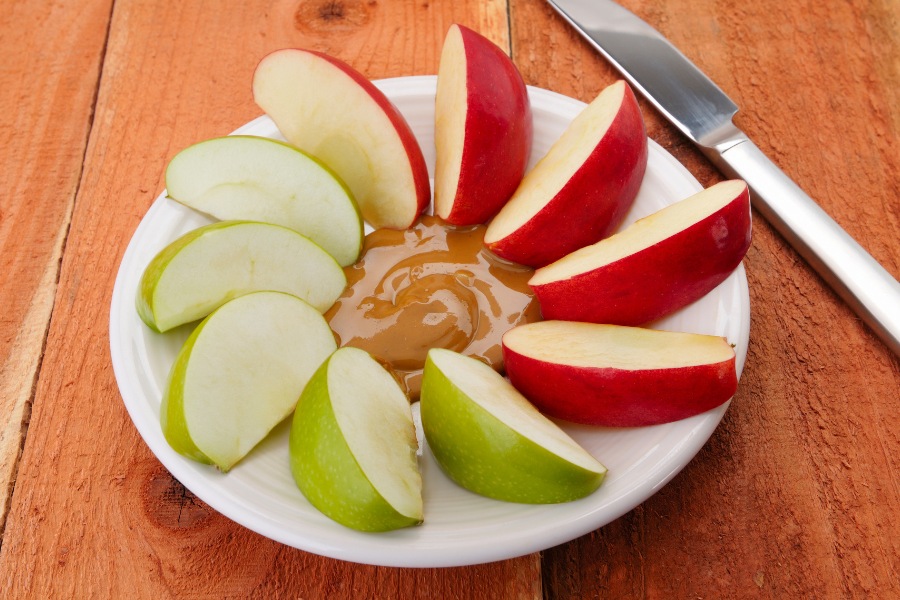
Apple slices with peanut butter – A delicious and well-balanced snack option for diabetics
Apples and peanut butter make a classic and delicious snack combination that is also suitable for people with diabetes. Apples are rich in fiber and antioxidants, while peanut butter provides a good dose of healthy fats and protein. The combination of these two ingredients creates a balanced snack that can help regulate blood sugar levels and keep hunger at bay. When choosing peanut butter, opt for natural varieties without added sugars or hydrogenated oils. Spread a tablespoon of peanut butter on apple slices for a tasty and satisfying snack that will keep you energized throughout the day.
Apple slices with peanut butter are a fantastic snack option for people with diabetes, and for good reason. Here’s why:
-
Balance of nutrients: Apples are a good source of fiber, which helps slow down the absorption of sugar into the bloodstream, while peanut butter provides protein and healthy fats, both of which contribute to satiety and help prevent blood sugar spikes.
-
Portion control: This snack is naturally portion-controlled, with a small apple and a tablespoon of peanut butter providing a satisfying and balanced combination of nutrients.
-
Deliciousness: It’s a simple yet tasty snack that can help satisfy cravings without going overboard on sugar or unhealthy fats.
Here are some additional tips for enjoying this snack as a person with diabetes:
-
Choose a low-glycemic apple variety: Apples like Granny Smith, Gala, or Fuji have a lower glycemic index (GI) than other varieties, meaning they are less likely to cause a spike in blood sugar.
-
Opt for natural peanut butter: Look for peanut butter that is made with just peanuts and salt, and avoid varieties that contain added sugar or unhealthy fats.
-
Mind your portion size: While a small apple and a tablespoon of peanut butter is a generally good guideline, it’s important to be mindful of your individual needs and adjust portion sizes accordingly.
Remember, it’s always a good idea to talk to your doctor or a registered dietitian for personalized advice on managing your diabetes and choosing the best snacks for your individual needs.
Greek Yogurt with Berries – High-protein and low-sugar snack for diabetics
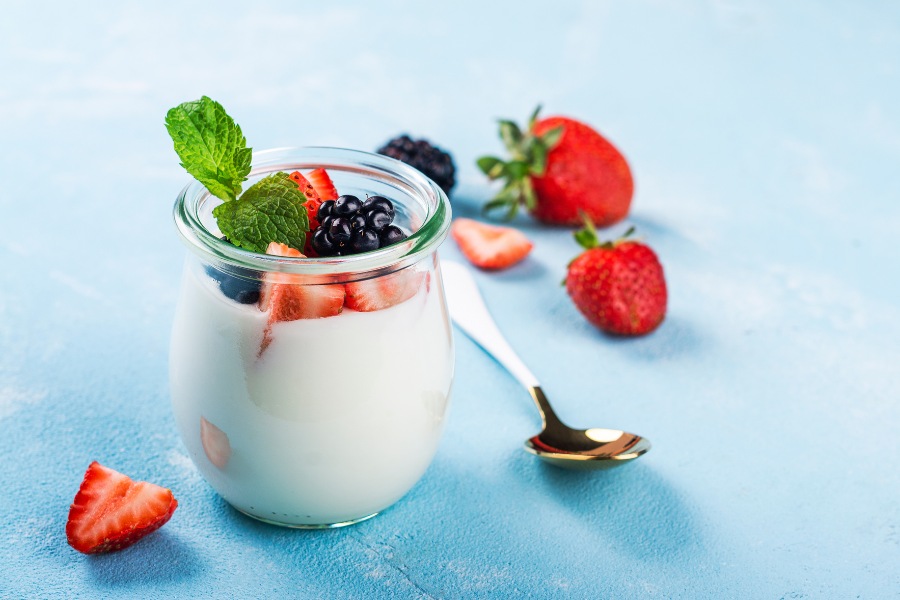
Greek Yogurt with Berries – High-protein and low-sugar snack for diabetics
Greek yogurt is an excellent snack choice for people with diabetes due to its high protein content and low sugar content. Protein helps slow down the digestion of carbohydrates, preventing blood sugar spikes. Additionally, Greek yogurt contains probiotics that promote gut health and calcium for strong bones. Pairing Greek yogurt with fresh berries adds natural sweetness and additional fiber, vitamins, and antioxidants. Berries, such as strawberries, blueberries, and raspberries, are low in sugar and high in nutrients, making them a perfect addition to your diabetes-friendly snack repertoire.
Here’s why it’s a good choice:
- High protein: Greek yogurt is packed with protein, which helps you feel fuller for longer and can help regulate blood sugar levels. A typical 6-ounce serving of plain Greek yogurt can contain around 15-20 grams of protein, compared to just 6-8 grams in regular yogurt.
- Low sugar: Plain Greek yogurt is naturally low in sugar, typically containing around 4-8 grams per serving. You can further control the sweetness by adding your own fruit, like berries, which are also relatively low in sugar and high in fiber.
- Fiber: Berries are a good source of fiber, which can also help regulate blood sugar levels and keep you feeling full.
- Healthy fats: Some Greek yogurt options contain full or low-fat yogurt. Choosing full-fat yogurt can provide some healthy fats, which can also help slow down the absorption of sugar into the bloodstream.
Here’s a simple recipe for this delicious and diabetic-friendly snack:
Ingredients:
- 1 cup plain, low-fat Greek yogurt
- 1/2 cup mixed berries (blueberries, raspberries, strawberries, etc.)
- 1/4 teaspoon ground cinnamon (optional)
Instructions:
- In a bowl, combine the Greek yogurt and berries.
- Sprinkle with cinnamon, if desired.
- Enjoy!
Tips:
- For added crunch and healthy fats, you can also top your yogurt with a sprinkle of chopped nuts or seeds.
- If you prefer a sweeter yogurt, opt for unsweetened Greek yogurt and add a small amount of stevia, monk fruit extract, or a mashed banana for natural sweetness.
- Be sure to choose unsweetened or plain Greek yogurt to avoid added sugars.
- Remember, portion control is key. While Greek yogurt is a healthy choice, it still contains calories. Stick to a serving size of 6-ounces or less.
By incorporating this healthy and delicious snack into your diet, you can help manage your blood sugar levels and keep yourself feeling satisfied between meals.
Hard Boiled Eggs – A Convenient and Protein-Rich Snack for Diabetes

Hard Boiled Eggs – A Convenient and Protein-Rich Snack for Diabetes
Hard-boiled eggs are a convenient and protein-rich snack that can be enjoyed on the go. They are low in carbohydrates and contain essential nutrients such as vitamins A, D, and B12, as well as iron and selenium. Protein helps promote satiety and stabilize blood sugar levels, making hard-boiled eggs an ideal snack for people with diabetes. Prepare a batch of hard-boiled eggs at the beginning of the week for quick and easy snacking throughout the day. Enjoy them alone or pair them with a side of raw vegetables for an extra nutritional boost.
- High in protein: One large hard-boiled egg boasts around 6.3 grams of protein, which is crucial for diabetes management. Protein helps regulate blood sugar levels by slowing down the absorption of carbohydrates, preventing those unwanted spikes.
- Low in carbs: Hard-boiled eggs are practically carb-free, making them a perfect choice for individuals following a low-carb diet, commonly recommended for diabetes management.
- Portable and convenient: Boiling a batch of eggs allows for easy meal prepping. They don’t require refrigeration until after cooking, making them a grab-and-go snack for busy schedules.
- Rich in essential nutrients: Beyond protein, eggs offer a treasure trove of essential vitamins and minerals, including vitamin D, which may play a role in blood sugar control.
While hard-boiled eggs are a great snack on their own, you can also jazz them up with various healthy additions like:
- Small sliced vegetables such as bell peppers, cucumbers or celery to eat together
- Sprinkle with herbs and spices to add flavor to the dish
- A dollop of low-fat yogurt or hummus for dipping
Remember, while hard-boiled eggs are a healthy and convenient option, it’s crucial to consult with a healthcare professional or registered dietitian for personalized dietary advice tailored to your specific needs and diabetes management plan.
Hummus with Carrots or Pita Bread – A delicious and fiber-rich snack option for diabetics
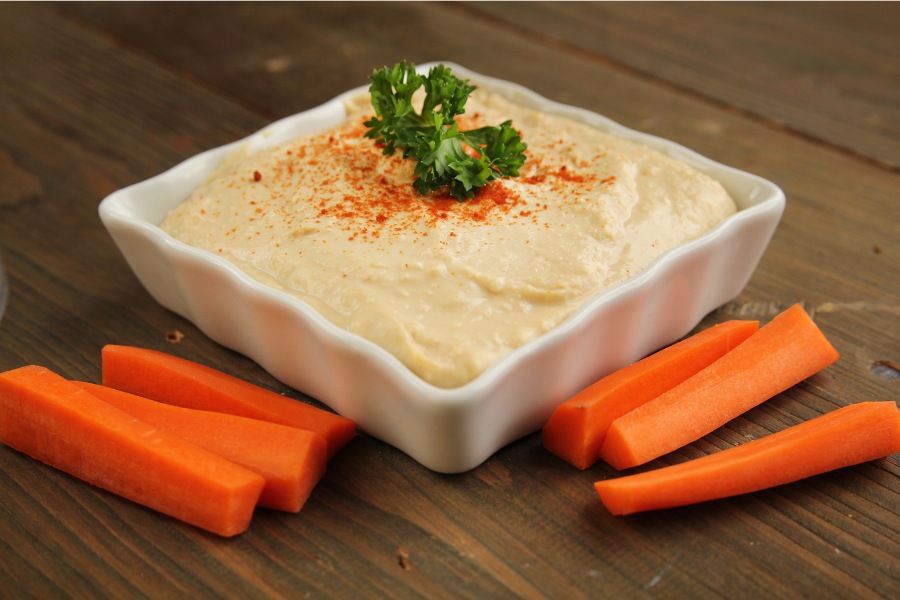
Hummus with Carrots or Pita Bread – A delicious and fiber-rich snack option for diabetics
Hummus is a delicious and fiber-rich snack option that pairs well with carrots or whole grain pita bread. Made from chickpeas, hummus is an excellent source of plant-based protein and fiber. Protein and fiber work together to slow down the digestion of carbohydrates, preventing blood sugar spikes. Carrots, on the other hand, are low in calories and high in fiber and antioxidants. Together, hummus and carrots create a satisfying and flavorful snack that will keep you feeling full and energized throughout the day.
Both hummus with carrots and hummus with pita bread are excellent and delicious snack options for diabetics, offering different benefits:
Hummus with carrots:
- High in fiber: Both carrots and hummus are good sources of fiber, which helps regulate blood sugar levels by slowing down digestion and absorption of carbohydrates.
- Low glycemic index: Carrots have a low glycemic index (GI), meaning they cause a gradual rise in blood sugar levels, making them a good choice for diabetics.
- Rich in vitamins and minerals: Carrots are rich in beta-carotene (converts to Vitamin A), vitamin K1, and potassium, all beneficial for overall health.
Hummus with pita bread:
- Provides complex carbohydrates: Pita bread is a source of complex carbohydrates, which release energy slowly and help maintain stable blood sugar levels.
- Good source of protein and healthy fats: Hummus is a good source of protein and healthy fats, which can help with satiety and manage blood sugar levels.
- Variety and taste: Pita bread adds a different texture and flavor dimension to the hummus, making it a more satisfying snack.
Ultimately, the best choice depends on your personal preferences and dietary needs..
Here are some additional tips:
- Portion control: Be mindful of portion sizes, as both hummus and pita bread are calorie-dense.
- Choose whole-wheat pita bread: Opt for whole-wheat pita bread for its higher fiber content compared to white pita bread.
- Variety is key: Rotate your snacks to include other healthy options like fruits, vegetables, nuts, and seeds.
By making informed choices and maintaining a balanced diet, you can manage your diabetes and enjoy delicious and nutritious snacks like hummus with carrots or pita bread.
Edamame Beans – A Plant-Based Protein Snack for Diabetes
Edamame beans are young soybeans that are packed with plant-based protein, fiber, and essential nutrients. They are low in carbohydrates and have a minimal impact on blood sugar levels, making them an excellent snack option for people with diabetes. Edamame beans are also rich in antioxidants, such as vitamin C and vitamin E, which can help reduce inflammation and support overall health. To enjoy edamame beans as a snack, simply steam or boil them and season with a sprinkle of salt or your favorite spices.
Edamame beans are indeed a great plant-based protein snack option for people with diabetes. Here’s why:
- Low glycemic index: Edamame has a glycemic index (GI) of 17, which is considered very low. This means it has a minimal impact on blood sugar levels, making it a safe and healthy choice for people with diabetes who need to manage their blood sugar levels.
- High protein content: Edamame is a good source of plant-based protein, containing about 17 grams of protein per cup. Protein helps with blood sugar control and can also help you feel satiated and manage your weight, both of which are important for people with diabetes.
- Fiber content: Edamame also contains some fiber, which can further help with blood sugar control and digestion.
- Other nutrients: Edamame is a good source of several other nutrients, including vitamin K, folate, and magnesium, which are all important for overall health.
Here are some additional tips for enjoying edamame as a snack:
- Portion control: A typical serving of edamame is about 1/2 cup (shelled). Be mindful of portion sizes, as even healthy foods can affect your blood sugar if you eat too much.
- Flavoring: Edamame can be enjoyed plain, or you can add some flavor with a sprinkle of sea salt, black pepper, or your favorite spices. Avoid adding too much salt, as sodium can be a concern for people with diabetes.
- Pairing: Pair your edamame with other healthy snacks, such as chopped vegetables or a small piece of fruit, to help you feel full and satisfied.
Overall, edamame is a delicious and nutritious snack option for people with diabetes. It is low in glycemic index, high in protein, and contains other essential nutrients. Just be mindful of portion sizes and flavoring choices to keep your blood sugar levels under control.
Shredded cheese – A calcium-rich snack option for diabetics

Shredded cheese – A calcium-rich snack option for diabetics
Shredded cheese is a tasty and portion-controlled snack that provides a good amount of calcium and protein. Calcium is essential for maintaining strong bones, especially for people with diabetes who may be at increased risk for bone-related complications. Choose low-fat or reduced-fat varieties of cheese to keep the calorie and saturated fat content in check. Enjoy a small handful of shredded cheese on its own or pair it with whole grain crackers or raw vegetables for a more substantial snack.
Here’s why shredded cheese can be a good choice:
- Rich in calcium: Cheese is an excellent source of calcium, which is important for bone health and may help regulate blood sugar levels.
- Low in carbs: Most cheese varieties are naturally low in carbs, making them a suitable choice for people with diabetes who need to manage their carbohydrate intake.
- High in protein: Cheese is also a good source of protein, which can help you feel full and satisfied.
However, it’s important to consider the following:
- Fat content: Cheese is also high in fat, so it’s important to choose lower-fat varieties and limit your portion sizes.
- Sodium content: Some cheeses can be high in sodium, so it’s important to check the label and choose varieties that are lower in sodium.
Here are some tips for choosing shredded cheese for a diabetic diet:
- Opt for lower-fat varieties: Look for shredded cheeses that are labeled as “light” or “low-fat.” These varieties will have less fat and calories per serving.
- Choose lower-carb varieties: Some cheeses, such as cheddar and mozzarella, are naturally lower in carbs than others.
- Pay attention to portion sizes: A typical serving of shredded cheese is about 1 ounce (28 grams). Be sure to measure out your portions to avoid overeating.
In conclusion, shredded cheese can be a healthy and satisfying snack option for diabetics, but it’s important to choose lower-fat and lower-carb varieties and limit your portion sizes.
Popcorn – A Whole Grain Snack for Diabetes in Moderation
Popcorn can be a satisfying and crunchy snack option for people with diabetes when consumed in moderation. Popcorn is a whole grain that is low in calories and high in fiber. Fiber helps slow down the absorption of carbohydrates, preventing blood sugar spikes. It is important to note that pre-packaged microwave popcorn or movie theater popcorn often contain added fats, salt, and sugar. To keep your snack healthy, opt for plain air-popped popcorn and season it with herbs, spices, or a sprinkle of Parmesan cheese.
Popcorn: A Surprisingly Good Snack for Managing Diabetes.
- Type of Grain: Popcorn is a whole grain, meaning it contains all parts of the grain kernel (the bran, germ, and endosperm). Whole grains are an essential part of a healthy diet for everyone, including people with diabetes.
- Fiber Content: Popcorn is a good source of fiber. Fiber helps slow down digestion, preventing blood sugar spikes and promoting a feeling of fullness.
- Glycemic Index (GI): Air-popped popcorn has a medium glycemic index. GI measures how fast food eats and can increase blood sugar levels. Medium GI foods are a good choice for people with diabetes.
- Calorie Control: Plain, air-popped popcorn is naturally low in calories and fat, making it a good choice for a satisfying snack that won’t derail your blood sugar management.
Tips for Diabetics Enjoying Popcorn:
- Portion Control Matters: Stick to around 3 cups of air-popped popcorn for a sensible portion size.
- Choose Air-Popped: Air-popped popcorn is the healthiest option. Avoid pre-packaged, flavored varieties which can be loaded with sugar, salt, and unhealthy fats.
- Go Easy on Toppings: While a little salt is fine, too much butter, sugar, or other high-calorie toppings can undermine the health benefits of popcorn. Some healthy topping ideas include:
- Nutritional yeast
- Herbs and spices (garlic powder, chili powder, paprika, etc.)
- A very light drizzle of olive oil and a sprinkle of Parmesan cheese
Important Note: Always consult with your doctor or a registered dietitian to determine how popcorn can best fit into your personalized diabetes management plan.
Roasted Green Beans – A Crunchy and Low-Carb Snack for Diabetes
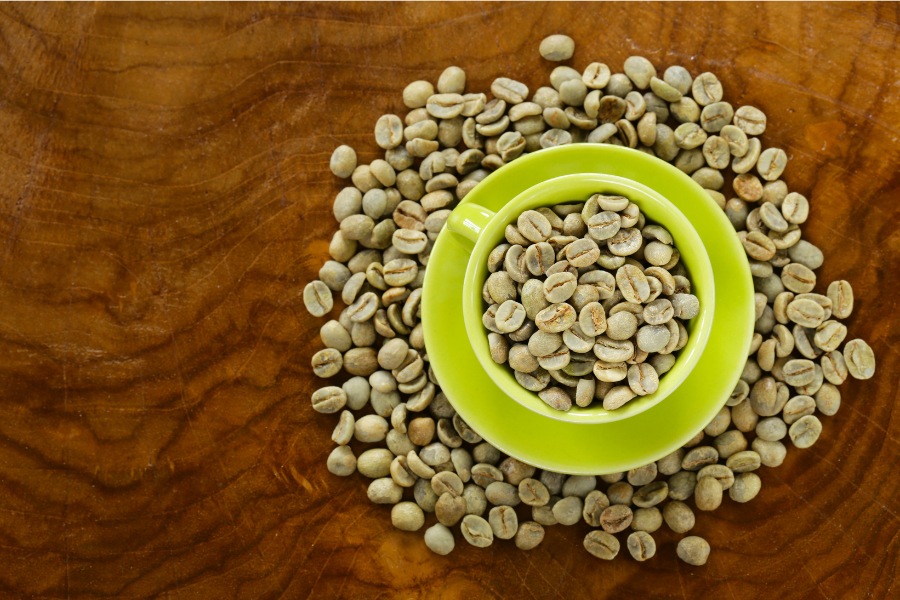
Roasted Green Beans – A Crunchy and Low-Carb Snack for Diabetes
Roasted green beans are a delicious and low-carb snack that can satisfy your cravings for something crunchy. Green beans are low in calories and carbohydrates, making them a perfect snack option for people with diabetes. They also contain essential nutrients such as vitamins A, C, and K, as well as fiber and antioxidants. To make roasted green beans, simply toss them with a little olive oil, salt, and pepper, and roast them in the oven until they are crispy. Enjoy them on their own or pair them with a protein-rich dip for a more substantial snack.
Roasted green beans are a fantastic snack option for people with diabetes, and anyone looking for a healthy and delicious treat. Here’s why they’re a great choice:
Low in Carbs: Green beans are naturally low in carbs, making them a suitable snack for individuals managing blood sugar levels. They typically contain around 5-7 grams of carbs per serving, depending on the portion size.
High in Fiber: Green beans are a good source of fiber, which can help with satiety and blood sugar control. Fiber slows down digestion, helping you feel fuller for longer and preventing blood sugar spikes.
Packed with Nutrients: Green beans are a powerhouse of vitamins and minerals, including vitamins A, C, and K, as well as potassium and folate. These nutrients play an important role in helping your body maintain overall health.
Simple and Versatile: Roasting green beans is a simple and quick way to prepare them. You just need minimal ingredients like olive oil, salt, and pepper. Additionally, you can customize them with various herbs and spices to create different flavor profiles.
Here’s a basic recipe for roasted green beans:
Ingredients:
- 1 pound fresh green beans, trimmed
- 1 tablespoon olive oil
- Salt and pepper to taste
- Optional: Garlic powder, onion powder, paprika, or your favorite spices
Instructions:
- Preheat your oven to 425°F (220°C).
- Mix green beans with olive oil and salt and pepper.
- Spread green beans on the baking tray in a thin layer.
- Roast for 15-20 minutes, or until tender-crisp and slightly browned.
- Sprinkle with your desired spices (optional) and enjoy!
Tips:
- For extra crispiness, toss the green beans with a cornstarch or almond flour coating before baking.
- You can also roast them with other vegetables like cherry tomatoes, red onion, or bell peppers.
- Leftover roasted green beans can be stored in an airtight container in the refrigerator for up to 3 days.
Remember, while roasted green beans are a healthy snack, it’s crucial to consult with your doctor or registered dietitian for personalized dietary advice to manage your diabetes effectively.
Cucumber Slices with Dill – A refreshing and hydrating snack option for diabetics
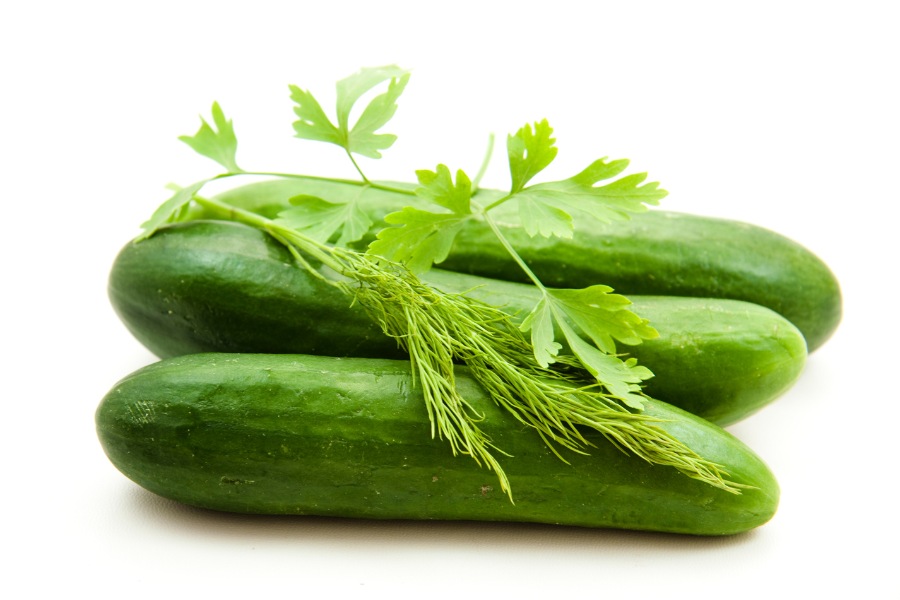
Cucumber Slices with Dill – A refreshing and hydrating snack option for diabetics
Cucumber slices with dill make a refreshing and hydrating snack that is perfect for hot summer days. Cucumbers are low in calories and carbohydrates, making them an excellent choice for people with diabetes. Cucumber Slices with Dill also has a high water content, which can help you stay hydrated. Dill adds a burst of flavor and contains antioxidants that may have anti-inflammatory properties. Enjoy cucumber slices with a sprinkle of fresh dill on their own or pair them with a dollop of Greek yogurt for a creamy and cooling snack.
Cucumber slices with dill are a fantastic snack option for diabetics for several reasons:
- Low in Carbs and Sugar: Cucumbers are incredibly low in both carbs and sugar, making them a perfect choice for managing blood sugar levels.
- Hydrating: They are also rich in water, which is crucial for staying hydrated, especially important for people with diabetes.
- Nutrient Rich: Cucumbers offer essential vitamins and minerals, including vitamin K, potassium, and magnesium, contributing to overall health.
- Flavorful and Versatile: The fresh flavor of cucumbers pairs beautifully with the herbaceous notes of dill, making for a simple yet satisfying snack.
Here’s a basic way to enjoy cucumber slices with dill:
Ingredients:
- Cucumber(s)
- Fresh dill (or dried dill)
- Optional: Pinch of salt and black pepper
Instructions:
- Wash the cucumber(s) and slice them thinly.
- Wash and chop the fresh dill, or use a pinch of dried dill.
- Sprinkle the dill over the cucumber slices.
- Optionally, add a pinch of salt and black pepper for extra flavor.
Tips:
- For a more creative twist, consider adding a dollop of plain Greek yogurt or a sprinkle of crumbled feta cheese for a touch of protein and creaminess.
- If you prefer a tangy flavor, you can sprinkle the cucumbers with a little vinegar or lemon juice.
- This snack is best enjoyed fresh, but you can store leftover slices in an airtight container in the refrigerator for a few hours.
By incorporating cucumber slices with dill into your snack routine, you can enjoy a delicious, refreshing, and diabetic-friendly option that helps manage your blood sugar and keeps you hydrated.
Bell pepper slices with guacamole – Nutritious snack for diabetics

Bell pepper slices with guacamole – Nutritious snack for diabetics
Bell pepper slices with guacamole are a nutrient-dense and delicious snack that can satisfy your cravings for something savory. Bell peppers are low in calories and carbohydrates, making them a suitable choice for people with diabetes. They are also packed with vitamins A and C, as well as antioxidants that support immune health. Guacamole, made from mashed avocados, provides healthy fats and fiber, which can help stabilize blood sugar levels and promote satiety. Slice bell peppers into strips and serve them with a side of homemade guacamole for a satisfying and nutritious snack.
- Bell peppers: They are low in calories and carbohydrates, and a good source of fiber and vitamin C. Fiber helps slow down the absorption of sugar into the bloodstream, which can help with blood sugar control.
- Guacamole: Avocados, the main ingredient in guacamole, are a good source of healthy fats, fiber, and several vitamins and minerals. Healthy fats can help you feel full and satisfied, and may also help improve insulin sensitivity.
Here are some additional tips for making this snack even more nutritious:
- Use homemade guacamole: This allows you to control the ingredients and avoid added sugars or unhealthy fats that may be found in store-bought versions.
- Choose the right type of bell pepper: Red, yellow, and orange bell peppers are generally higher in vitamins and antioxidants than green bell peppers.
- Portion control: Even healthy snacks should be enjoyed in moderation. A serving of guacamole is typically about 2 tablespoons, and a serving of bell peppers is about 1 cup.
Overall, bell pepper slices with guacamole can be a healthy and delicious snack option for people with diabetes. Just be sure to practice portion control and choose healthy ingredients.
It’s important to note that everyone’s body reacts differently to food, and what works for one person may not work for another. It is always best to talk to your doctor or a registered dietitian to create a personalized meal plan that meets your individual needs.
Celery with Cream Cheese – A Low-Calorie and Fiber-Rich Snack for Diabetes
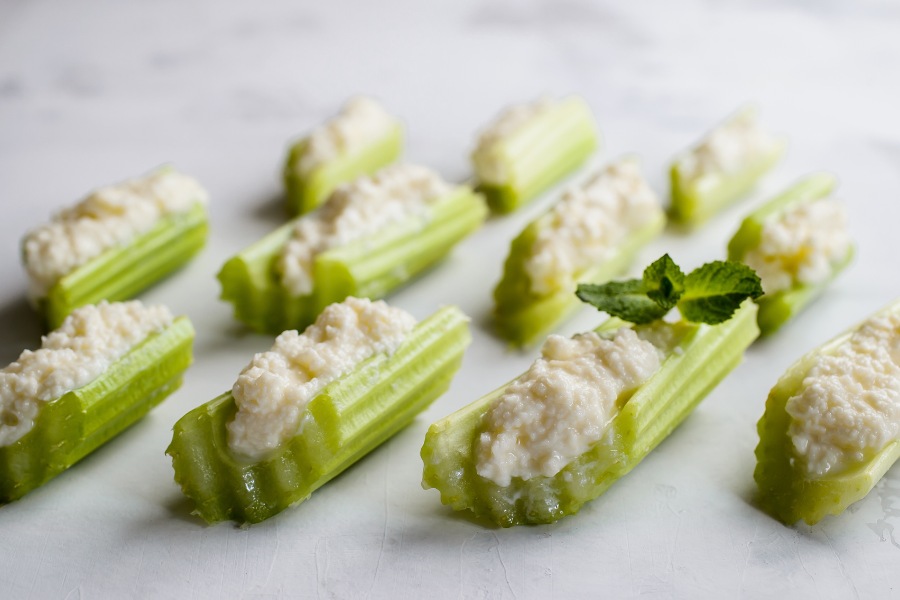
Celery with Cream Cheese – A Low-Calorie and Fiber-Rich Snack for Diabetes
Celery with cream cheese is a low-calorie and fiber-rich snack that can be enjoyed any time of the day. Celery is incredibly low in calories and carbohydrates, making it an excellent choice for people with diabetes. It is also high in fiber, which can help regulate blood sugar levels and support digestive health. Pair celery sticks with a smear of cream cheese for a creamy and satisfying snack that will keep you feeling full and satisfied.
Celery with cream cheese can be a healthy snack for people with diabetes, but it’s important to be mindful of portion sizes and choose the right type of cream cheese.
Here’s why celery with cream cheese can be a good snack for diabetes:
- Low in calories: Celery is a non-starchy vegetable that is very low in calories. One cup of chopped celery contains only about 16 calories.
- High in fiber: Celery is a good source of fiber, which can help to regulate blood sugar levels. Fiber slows the absorption of sugar into the bloodstream, which can help prevent and reduce the risk of blood sugar spikes.
- Cream cheese adds protein and healthy fats: Cream cheese is a good source of protein and healthy fats, which can help to keep you feeling full and satisfied. However, it’s important to choose a low-fat or reduced-fat cream cheese, as full-fat cream cheese can be high in saturated fat.
Here are some things to keep in mind when enjoying celery with cream cheese as a snack for diabetes:
- Portion control: It’s important to be mindful of portion sizes when eating any food, including celery and cream cheese. A good rule of thumb is to stick to about 2-3 tablespoons of cream cheese and 4-5 celery sticks.
- Type of cream cheese: Choose a low-fat or reduced-fat cream cheese to limit your intake of saturated fat. You can also find flavored cream cheese varieties that are lower in sugar and fat.
- Blood sugar monitoring: It’s important to monitor your blood sugar levels regularly, especially if you are trying a new snack. This will help you to see how your body reacts to the snack and adjust your portion size or frequency as needed.
Here are some tips for making your celery and cream cheese snack even healthier:
- Add other vegetables: Try adding other low-carb vegetables to your snack, such as cucumber, bell peppers, or sugar snap peas.
- Use herbs and spices: Add some herbs and spices to your cream cheese for extra flavor, such as chives, dill, or garlic powder.
- Pair it with protein: Pair your celery and cream cheese snack with a source of protein, such as a handful of almonds or a hard-boiled egg. This will help your body feel full.
By following these tips, you can enjoy celery with cream cheese as a healthy and satisfying snack for diabetes.
Carrot sticks with almond butter – A satisfying and nutritious snack for diabetics
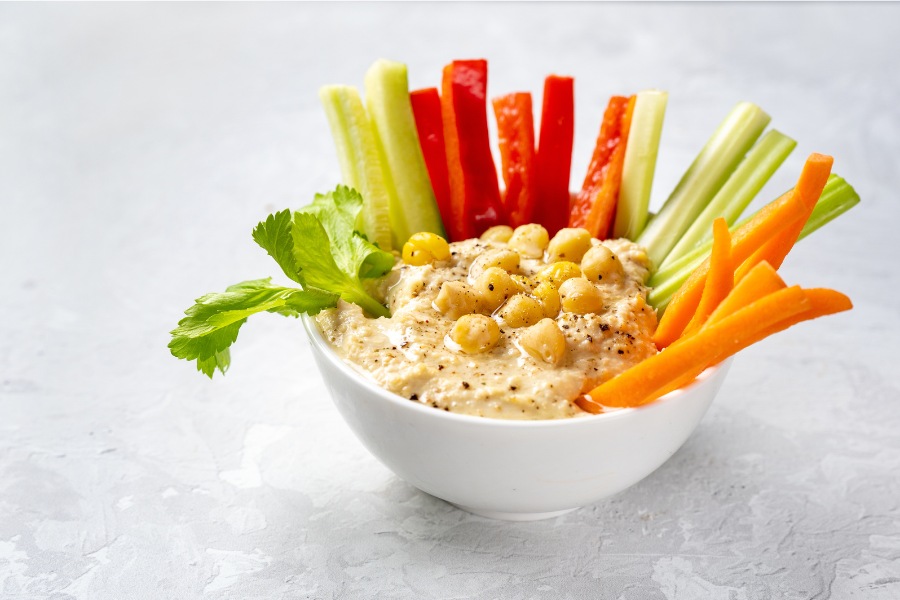
Carrot sticks with almond butter – A satisfying and nutritious snack for diabetics
Carrot sticks with almond butter make a satisfying and nutrient-packed snack that is perfect for people with diabetes. Carrots are low in calories and carbohydrates, while almond butter provides healthy fats, protein, and fiber. The combination of these two ingredients creates a snack that is rich in vitamins, minerals, and antioxidants. To enjoy this snack, simply slice carrots into sticks and dip them into a tablespoon of almond butter for a delicious and satisfying treat.
Carrot sticks with almond butter are a fantastic snack option for diabetics, and for good reason. Here’s why:
- Low glycemic index (GI): Carrots have a low GI, meaning they cause a gradual rise in blood sugar levels, which is ideal for managing diabetes.
- High in fiber: Carrots are a good source of fiber, which helps slow down digestion and absorption of carbohydrates, further contributing to stable blood sugar levels.
- Healthy fats and protein: Almond butter is rich in healthy fats and protein, both of which help you feel full and satisfied, preventing overeating and unhealthy snacking.
Making this snack is as easy as 1-2-3:
- Wash and cut carrots into sticks of your desired size.
- Choose a natural almond butter with minimal added sugar or salt.
- Dip the carrot sticks in the almond butter and enjoy!
Tips:
- For added flavor, you can sprinkle the carrot sticks with a pinch of cinnamon or a squeeze of lemon juice.
- If you prefer a creamier dip, you can thin out the almond butter with a little water or milk.
- Portion control is key, even with healthy snacks. Aim for a moderate serving size to avoid consuming too much at once.
Consult with a dietitian or healthcare professional to create a personalized diabetes meal plan tailored to your individual needs and preferences.
Apple Cheese Slices – A Sweet and Savory Combination for Diabetes-Friendly Snacking
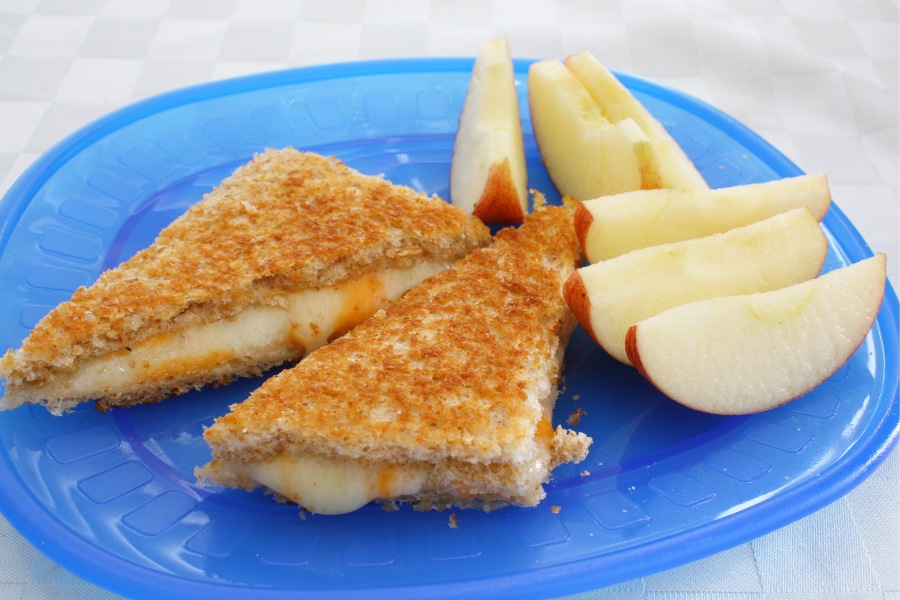
Apple Cheese Slices – A Sweet and Savory Combination for Diabetes-Friendly Snacking
Apple cheese slices offer a delightful combination of sweet and savory flavors that make for a perfect diabetes-friendly snack. Apples are low in calories and carbohydrates, high in fiber, and packed with vitamins and antioxidants. Pairing apple slices with a small amount of cheese, such as cheddar or Swiss, adds protein and healthy fats, creating a balanced and satiating snack. Slice an apple and a small piece of cheese, and enjoy them together for a satisfying and delicious treat.
Apple slices paired with cheese can be a delightful and healthy snack for people with or without diabetes. This combination offers a satisfying blend of sweetness, savoryness, and nutrients.
Here’s why this snack is a great choice:
- Balanced Macronutrients: The combination of apples and cheese provides a good balance of carbohydrates, protein, and healthy fats. This helps keep you feeling full and satisfied for longer, preventing blood sugar spikes and crashes that can be problematic for people with diabetes.
- Fiber Richness: Apples are an excellent source of fiber, which helps regulate digestion and blood sugar levels.
- Calcium and Vitamin D: Cheese is a good source of calcium and vitamin D, both important nutrients for bone health and overall well-being.
Tips for a Diabetes-Friendly Snack:
- Portion Control: While this snack is healthy, remember to practice portion control. Aim for a small apple (around 3 inches in diameter) and a thin slice of cheese (around 1 ounce).
- Cheese Selection: Opt for lower-fat cheese options like cheddar, mozzarella, or swiss. Avoid processed cheeses or those high in saturated fat.
- Variety is Key: Explore different apple and cheese pairings to keep things interesting. You can try Granny Smith apples with cheddar cheese, honeycrisp apples with goat cheese, or Fuji apples with brie.
Beyond Slices:
- Apple and Cheese Wraps: Spread a thin layer of cream cheese on an apple slice, top with a slice of cheese and your favorite protein like turkey or ham, and roll it up.
- Cheese and Apple Skewers: Thread apple slices and cheese cubes onto skewers for a fun and easy snack.
- Salads: Add sliced apples and cheese to your salad for a burst of sweetness and creaminess.
Remember: While this snack can be a healthy choice for people with diabetes, it’s always best to consult with a healthcare professional or registered dietitian for personalized dietary advice. They can help you create a meal plan that meets your specific needs and preferences.
Dark chocolate – Delicious and rich in antioxidants that treat diabetes in moderation

Dark Chocolate – A Tasty and Antioxidant-Rich Treat for Diabetes in Moderation
Dark chocolate can be enjoyed in moderation as a tasty and antioxidant-rich treat for people with diabetes. Dark chocolate with a high cocoa content (70% or more) contains less sugar and more fiber than milk chocolate, making it a better choice for blood sugar control. It is also rich in antioxidants called flavonoids, which have been shown to have various health benefits, including improving insulin sensitivity and reducing inflammation. Enjoy a small piece of dark chocolate as an occasional treat to satisfy your sweet tooth.
Dark Chocolate: Potential Benefits for Diabetes
-
Improved Insulin Sensitivity: Polyphenols, naturally occurring antioxidants in dark chocolate, may improve how the body uses insulin, helping control blood sugar levels.
- Heart Health Promotion: Dark chocolate’s flavonoids can support heart health, a crucial aspect of diabetes care. These compounds may improve blood pressure and reduce the risk of heart disease.
- Antioxidant Power: Antioxidants in dark chocolate fight harmful molecules called free radicals, reducing inflammation and potentially aiding in diabetes management.
Key Considerations
-
Choose the right type: Opt for dark chocolate with at least 70% cocoa content. The higher the cocoa percentage, the lower the sugar content will be. Look for sugar-free varieties!
-
Portion Control is Key: Stick to moderate serving sizes. A small square or two (around 30g) after meals is a good starting point.
-
Factor it into your Carb Count: Don’t forget that dark chocolate still contains carbohydrates. Discuss with your doctor or a registered dietitian to strategize how to best include it in your meal plan.
Remember: Dark chocolate is a potential addition to a healthy, balanced diet for individuals with diabetes – not a cure-all. Always prioritize whole foods like fruits, vegetables, and whole grains while managing your diabetes.
Disclaimer: Consult your healthcare provider to create a personalized dietary plan that best suits your individual needs and health status.
Conclusion: Incorporating Healthy Snacks into Your Diabetes Management Plan
Incorporating healthy snacks into your diabetes management plan is essential for maintaining stable blood sugar levels and supporting overall health. The snacks mentioned in this article, such as almonds, apple slices with peanut butter, Greek yogurt with berries, and hard-boiled eggs, are just a few examples of the many delicious and diabetes-friendly options available. Remember to choose snacks that are low in carbohydrates, high in fiber and protein, and packed with essential nutrients. By making mindful snack choices, you can take control of your diabetes and enjoy a balanced and healthy lifestyle.
Discover a variety of diabetes-friendly snacks and take control of your health today. Try incorporating some of these delicious options into your daily routine and experience the benefits of balanced and nutritious snacking. Remember to consult with your healthcare provider or a registered dietitian to tailor your snacking choices to your specific needs and preferences. Take charge of your diabetes management plan and enjoy a vibrant and fulfilling life.

